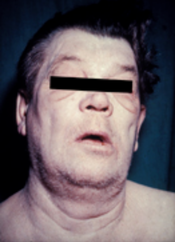Myxedema
| Myxedema | |
|---|---|
| Specialty | Endocrinology |
Myxedema or myxoedema is a term used synonymously with severe hypothyroidism. However, the term is also used to describe a dermatological change that can occur in hypothyroidism and some forms of hyperthyroidism.
In this context, myxedema refers to deposition of mucopolysaccharides in the dermis, which results in swelling of the affected area. One manifestation of myxedema occurring in the lower limb is pretibial myxedema, a hallmark of Graves disease, an autoimmune form of hyperthyroidism. Myxedema can also occur in Hashimoto's thyroiditis and other long-standing forms of hypothyroidism.
The word myxedema originates from [μύξα] Error: {{Lang}}: text has italic markup (help), taken from ancient Greek to convey 'mucus' or 'slimy substance', and [ὁοίδημα] Error: {{Lang}}: text has italic markup (help) for "swelling". It can also be thought as nonpitting edema, in contrast to pitting edema.
Signs and symptoms
Myxedema can occur in the lower leg (pretibial myxedema) and behind the eyes (exophthalmos).
Cause
Myxedema is known to occur in various forms of hypothyroidism, and also in Graves' disease. One of the hallmarks of Grave's disease is pretibial myxedema, myxedema of the lower limb.[1]
Myxedema is more common in women than in men.[2]
Myxedema can occur in:
- Hyperthyroidism, associated with pretibial myxedema and exophthalmos. Pretibial myxedema can occur in 1–4% of patients with Graves' disease, a cause of hyperthyroidism.[3]
- Hypothyroidism, including Hashimoto's thyroiditis. [citation needed]
Pathophysiology
Myxedema describes a specific form of cutaneous and dermal edema secondary to increased deposition of connective tissue components. The connective fibres are separated by an increased amount of protein and mucopolysaccharides. These can include glycosaminoglycans, hyaluronic acid, chondroitin sulfate and other mucopolysaccharides.[1] This protein-mucopolysaccharide complex binds water, producing non-pitting boggy edema, in particular around eyes, hands, feet and in the supraclavicular fossae. Myoxoedema is responsible for the thickening of the tongue and the laryngeal and pharnygeal mucous membranes, which results in thick slurred speech and hoarseness, both of which are seen commonly in hypothyroidism.
The increased deposition of glycosaminoglycan is not fully understood, however two mechanisms predominate:
- Fibroblast stimulation. It is thought that fibroblast stimulation by the thyroid stimulating hormone (TSH) receptor increases the deposition of glycosaminoglycan, which results in an osmotic edema and fluid retention. It is thought that many cells responsible for forming connective tissue react to increases in TSH levels. [citation needed]
- Lymphocyte stimulation. In Graves' thyroid disease, lymphocytes react against the TSH receptor. Lymphocytes react not only against thyroid receptors, but also any tissue with cells expressing the receptor. This can lead to tissue damage and scar tissue formation, explaining the deposition of glycosaminoglycans. [citation needed]
References
- ^ a b Berger, William D. James, Dirk M. Elston, Timothy G. Andrews' Diseases of the skin : clinical dermatology (11th ed.). [London]: Saunders/ Elsevier. ISBN 978-1-4377-0314-6.
{{cite book}}: CS1 maint: multiple names: authors list (link) - ^ Schneider, Arthur S.; Kim, Philip A. Szanto; with special contributions by Sandra I.; Swanson, Todd A. (2009). Pathology (4th ed.). Philadelphia: Wolters Kluwer Health/Lippincott Williams & Wilkins. p. 314. ISBN 1451109067.
- ^ "Pretibial Myxedema". Retrieved 2009-03-27.
This template is no longer used; please see Template:Endocrine pathology for a suitable replacement


